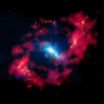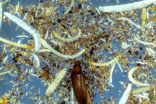(Press-News.org) One of the major problems in astronomy is measuring very large distances in the universe. The current most common methods measure relative distances, but now research from the Niels Bohr Institute demonstrates that precise distances can be measured using supermassive black holes. The results are published in the scientific journal, Nature.
The active galaxy NGC 4151 called the, 'Eye of Sauron' due to its similarity to the eye in the film Lord of the Rings, is a modest spiral galaxy. It has a supermassive black hole at its centre and this black hole is still active, that is to say it accretes gas clouds from its surroundings and it is this process that makes it possible to measure the distances to the galaxy.
"When the gas falls in towards the black hole, it is heated up and emits ultraviolet radiation. The ultraviolet radiation heats a ring of dust, which orbits the black hole at a large distance and this heats the dust causing it to emit infrared radiation. Using telescopes on Earth, we can now measure the time delay between the ultraviolet light from the black hole and the subsequent infrared radiation emitted from the dust cloud. The time difference is about 30 days and because we know the speed of light, we can calculate the real physical distance between the black hole and the encircling dust," explains Darach Watson, an associate professor at the Dark Cosmology Centre at the Niels Bohr Institute, University of Copenhagen.
Precise distance measurements
He explains that by combining the light from the two 10-meter Keck telescopes on Mauna Kea on Hawaii using a method called interferometry, they could achieve an effective resolution equivalent to a telescope with a perfect 85-meter diameter mirror (the distance between the two telescopes). This provides very high resolution - a hundred times better resolution than the Hubble Space Telescope - and allows them to measure the angle the dust ring makes in the sky, (about twelve millionth of a degree).
By now combining data about the angular size of the dust ring on the sky with the physical size of 30 light days, the distance from the Earth can be calculated by using simple geometri.
"We calculated the distance to be 62 million light-years. The previous calculations based on redshift (a change in the wavelength of the light due to the velocity of the object away from us) were between 13 million and 95 million light-years, so we have gone from a great deal of uncertainty to now being able to determine the precise distance. This is very significant for astronomical calculations of cosmic scale distances," says Darach Watson.
Pure magic
The research is primarily a collaboration between Darach Watson and Sebastian Hönig, who led the study and now works at the University of Southampton, but was then working at the Dark Cosmology Centre at the Niels Bohr Institute. Darach Watson says that they were both thrilled with the results.
"The process was almost magical. The most important thing about measuring distance is high precision - how accurate is the method. We knew that if we could get the uncertainty down to about 10 percent, it would be significant, but we had no idea that it was possible. When we first realised that we could carry out this measurement, we knew that the precision of the measurements of the anglular size using interferometry and the physical size based on the time delay were both only about 30 percent. Normally, when you combine two such numbers, the accuracy of the ratio is worse, so we expected an overall accuracy of 40 percent or so. But that was not what happened. It turned out that the greatest uncertainty in both measurements was the distribution of the brightness across the dust ring. And it was the same in both measurements, so when we took the ratio, the uncertainties cancelled - simply disappeared. Sebastian Hönig, after making the first calculation, came to me and said: "You'll never believe what the precision is, guess! Usually in science you fight so hard to get something to fit or work properly. But every so often - very rarely, something magical happens - it's like a gift and everything just falls into place. That is what happened here," explains Darach Watson.
Black holes are heavier than previously thought
Getting an accurate distance to the black hole removes one of the greatest uncertainties in measuring it's mass.
"The calculations of the mass (weight) of the supermassive black holes at the heart of galaxies depends on two main factors: the rotational speed of the stars in the galaxy and how far it is from the black hole to the stars. The rotational speed can be observed and the distance from the black hole out to the rotating disc of stars can now be calculated precisely using the new method. Our calculations show that the supermassive black holes are 40 percent heavier than previously thought. This fundamentally changes determinations of the masses of black holes," explains Darach Watson.
In addition, the new accurate distance measurements could become the most precise way to measure the 'Hubble's constant', that is, the rate at which the universe is expanding and which ultimately determines the age of the universe.
INFORMATION:
Contact:
Darach Watson, Associate Professor at the Dark Cosmology Centre at the Niels Bohr Institute, University of Copenhagen, +45 3532-5994, darach@dark-cosmology.dk
BOSTON - A promising experimental immunotherapy drug works best in patients whose immune defenses initially rally to attack the cancer but then are stymied by a molecular brake that shuts down the response, according to a new study led by researchers at Dana-Farber Cancer Institute and the Yale University School of Medicine.
The antibody drug, known as MPDL3280A, inhibits the brake protein, PD-L1, reviving the response by immune killer T cells, which target and destroy the cancer cells. In recent clinical trials, the PD-L1 checkpoint blocker caused impressive shrinkage ...
MADISON, Wis. -- It was fishermen off the coast of Peru who first recognized the anomaly, hundreds of years ago. Every so often, their usually cold, nutrient-rich water would turn warm and the fish they depended on would disappear. Then there was the ceaseless rain.
They called it "El Nino," The Boy -- or Christmas Boy -- because of its timing near the holiday each time it returned, every three to seven years.
El Nino is not a contemporary phenomenon; it's long been the Earth's dominant source of year-to-year climate fluctuation. But as the climate warms and the feedbacks ...
A new study has pulled together research into the most diverse place on earth to demonstrate how the organisms below-ground could hold the key to understanding how the worlds ecosystems function and how they are responding to climate change.
Published in Nature, the paper by Professor Richard Bardgett from The University of Manchester and Professor Wim van der Putten of the Netherlands Institute of Ecology, brings together new knowledge on this previously neglected area. The paper not only highlights the sheer diversity of life that lives below-ground, but also how rapid ...
Scientists from Queen Mary University of London have made a breakthrough in developing a new therapy for advanced bladder cancer - for which there have been no major treatment advances in the past 30 years.
Published today in Nature, the study examined an antibody (MPDL3280A) which blocks a protein (PD-L1) thought to help cancer cells evade immune detection.
In a phase one, multi-centre international clinical trial, 68 patients with advanced bladder cancer (who had failed all other standard treatments such as chemotherapy) received MPDL3280A, a cancer immunotherapy ...
In the race to find materials of ever increasing thinness, surface area and conductivity to make better performing battery electrodes, a lump of clay might have just taken the lead. Materials scientists from Drexel University's College of Engineering invented the clay, which is both highly conductive and can easily be molded into a variety of shapes and sizes. It represents a turn away from the rather complicated and costly processing--currently used to make materials for lithium-ion batteries and supercapacitors--and toward one that looks a bit like rolling out cookie ...
A team led by the University of Colorado Boulder has discovered an invisible shield some 7,200 miles above Earth that blocks so-called "killer electrons," which whip around the planet at near-light speed and have been known to threaten astronauts, fry satellites and degrade space systems during intense solar storms.
The barrier to the particle motion was discovered in the Van Allen radiation belts, two doughnut-shaped rings above Earth that are filled with high-energy electrons and protons, said Distinguished Professor Daniel Baker, director of CU-Boulder's Laboratory ...
In the near future, physicians may treat some cancer patients with personalized vaccines that spur their immune systems to attack malignant tumors. New research led by scientists at Washington University School of Medicine in St. Louis has brought the approach one step closer to reality.
Like flu vaccines, cancer vaccines in development are designed to alert the immune system to be on the lookout for dangerous invaders. But instead of preparing the immune system for potential pathogen attacks, the vaccines will help key immune cells recognize the unique features of cancer ...
LOS ANGELES - November 26, 2014 - Work supported by the Stand Up To Cancer (SU2C) - Cancer Research Institute (CRI) - Immunology Translational Research Dream Team, launched in 2012 to focus on how the patient's own immune system can be harnessed to treat some cancers have pioneered an approach to predict why advanced melanoma patients respond to a new life-saving melanoma drug. This new drug, pembrolizumab (Keytruda), was recently approved by the FDA. These findings are reported in Nature online November 26, 2014, ahead of print in the journal.
Over a two-year study, ...
High above Earth's atmosphere, electrons whiz past at close to the speed of light. Such ultrarelativistic electrons, which make up the outer band of the Van Allen radiation belt, can streak around the planet in a mere five minutes, bombarding anything in their path. Exposure to such high-energy radiation can wreak havoc on satellite electronics, and pose serious health risks to astronauts.
Now researchers at MIT, the University of Colorado, and elsewhere have found there's a hard limit to how close ultrarelativistic electrons can get to the Earth. The team found that ...
CORVALLIS, Ore. - The use of renewable energy in the United States could take a significant leap forward with improved storage technologies or more efforts to "match" different forms of alternative energy systems that provide an overall more steady flow of electricity, researchers say in a new report.
Historically, a major drawback to the use and cost-effectiveness of alternative energy systems has been that they are too variable - if the wind doesn't blow or the sun doesn't shine, a completely different energy system has to be available to pick up the slack. This lack ...









